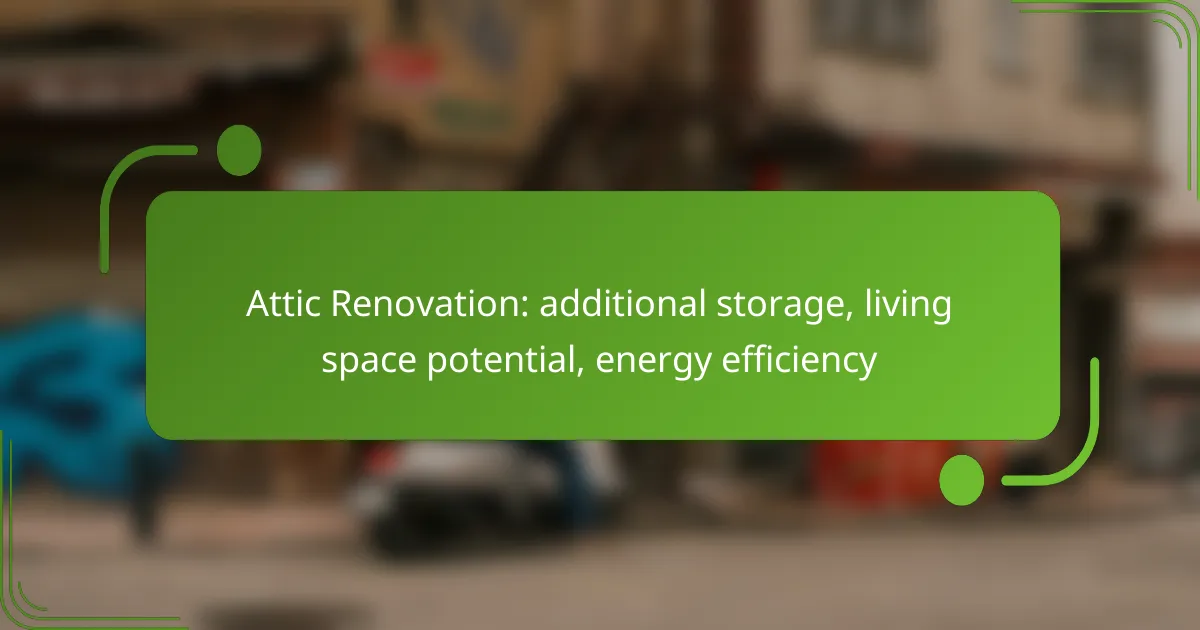Renovating your attic can unlock its hidden potential, providing additional storage and transforming it into valuable living space. This upgrade not only enhances the functionality of your home but also boosts its overall value. Furthermore, by improving insulation and addressing heat loss, attic renovations can lead to increased energy efficiency, resulting in lower utility bills and a more comfortable environment year-round.

How can attic renovation provide additional storage in London?
Attic renovation can significantly enhance storage options in London by transforming unused space into organized, functional areas. By optimizing the layout and incorporating smart storage solutions, homeowners can maximize their attic’s potential without extensive construction.
Built-in shelving solutions
Built-in shelving is an effective way to utilize attic space for storage. These shelves can be custom-fitted to the unique dimensions of the attic, allowing for efficient use of corners and sloped ceilings. Consider using materials that match your home’s interior for a seamless look.
When planning built-in shelves, aim for a mix of open and closed storage. Open shelves are great for displaying items, while closed cabinets can hide clutter. This balance helps maintain a tidy appearance while providing easy access to frequently used items.
Custom storage units
Custom storage units can be designed to fit specific needs and maximize the available space in your attic. Options include drawers, cubbies, and bins that can be tailored to accommodate seasonal items, holiday decorations, or even clothing. Investing in quality materials ensures durability and longevity.
Consider modular designs that can be adjusted as your storage needs change over time. This flexibility allows you to adapt the space without needing a complete overhaul, making it a practical choice for evolving storage requirements.
Utilizing vertical space
Utilizing vertical space is crucial in attic renovations, especially in areas with limited floor space. Tall shelving units or wall-mounted racks can help keep items off the floor and create a more open environment. This approach not only increases storage capacity but also enhances accessibility.
Incorporate hooks and pegboards to hang tools or equipment, which can free up shelf space for other items. When designing your storage layout, ensure that frequently accessed items are within easy reach, while less-used items can be stored higher up.

What are the benefits of converting an attic into living space in the UK?
Converting an attic into living space in the UK offers numerous advantages, including increased home value, additional functional areas, and enhanced family space. This transformation can significantly improve both the utility and appeal of your property.
Increased home value
One of the primary benefits of converting an attic is the potential increase in your home’s market value. Properties with additional living space typically attract higher offers, often recouping a significant portion of renovation costs. In the UK, a well-executed attic conversion can add tens of thousands of pounds to your property’s worth.
Before starting, consider consulting a local estate agent to understand how much value similar conversions have added in your area. This insight can guide your renovation decisions and help you set a realistic budget.
Additional bedroom or office
Converting your attic can provide much-needed additional bedrooms or a dedicated office space, which is increasingly valuable in today’s remote work environment. A well-designed attic bedroom can be a cozy retreat, while an office can enhance productivity away from the main living areas.
When planning, ensure that the space meets building regulations, particularly regarding ceiling height and access. Installing a proper staircase and ensuring adequate insulation will make the space comfortable and compliant.
Enhanced family space
An attic conversion can significantly enhance family space, offering a versatile area for playrooms, guest rooms, or hobby spaces. This additional room can help alleviate overcrowding in other parts of the home, providing a dedicated area for relaxation or activities.
Consider the layout carefully to maximize natural light and airflow. Adding skylights or dormer windows can create a brighter, more inviting atmosphere, making the space more enjoyable for family use.

How does attic renovation improve energy efficiency?
Attic renovation can significantly enhance energy efficiency by addressing heat loss and improving insulation. Proper upgrades can lead to lower energy bills and a more comfortable living environment throughout the year.
Insulation upgrades
Upgrading insulation in the attic is one of the most effective ways to improve energy efficiency. Proper insulation helps maintain a consistent indoor temperature by reducing heat transfer between the attic and living spaces below. Aim for an R-value that meets or exceeds local building codes, typically ranging from R-30 to R-60 depending on your climate.
Consider using materials like fiberglass batts, spray foam, or cellulose, each offering different benefits in terms of cost and effectiveness. Ensure that insulation is installed correctly to avoid gaps that can lead to energy loss.
Energy-efficient windows
Installing energy-efficient windows in the attic can further enhance energy efficiency by minimizing heat gain in the summer and heat loss in the winter. Look for windows with a low U-factor and high Solar Heat Gain Coefficient (SHGC) to ensure optimal performance.
Double or triple-pane windows with low-emissivity (Low-E) coatings are excellent choices, as they reflect heat while allowing natural light. When selecting windows, consider the orientation and local climate to maximize energy savings.
Ventilation improvements
Improving ventilation in the attic is crucial for energy efficiency, as it helps regulate temperature and moisture levels. Proper ventilation prevents heat buildup in the summer and reduces the risk of ice dams in winter, which can damage roofing and insulation.
Implement a balanced system of intake and exhaust vents to ensure adequate airflow. Ridge vents, soffit vents, and gable vents are common options. Regularly check and maintain these systems to ensure they are functioning effectively and not obstructed by debris.

What are the costs associated with attic renovation in England?
The costs of attic renovation in England can vary significantly based on the scope of the project, materials used, and local labor rates. Homeowners typically spend anywhere from £15,000 to £50,000, depending on whether they are adding storage, living space, or improving energy efficiency.
Average renovation costs
On average, a basic attic conversion can range from £15,000 to £30,000, while more extensive renovations that include insulation and structural changes can push costs to £50,000 or more. Factors influencing these costs include the size of the attic, the complexity of the design, and the quality of materials chosen.
For instance, a simple storage conversion may require less investment compared to a full living space with plumbing and electrical work. It’s essential to get multiple quotes from contractors to ensure a fair price.
Cost breakdown by project type
The cost of attic renovations can be broken down into several categories: structural changes, insulation, flooring, and finishing touches. Structural changes, such as reinforcing the roof or adding dormer windows, can account for a significant portion of the budget, often ranging from £5,000 to £15,000.
Insulation is another critical aspect, with costs typically between £1,000 and £3,000, depending on the materials used. Flooring and finishing touches, which include drywall, paint, and fixtures, can add an additional £3,000 to £10,000 to the overall cost.
Financing options available
Homeowners in England have several financing options for attic renovations. Many choose to use savings or home equity loans, which can provide lower interest rates compared to personal loans. Government schemes may also be available to assist with energy efficiency improvements, potentially offsetting some renovation costs.
Additionally, some contractors offer financing plans that allow homeowners to pay in installments. It’s advisable to compare different financing options to find the best fit for your budget and financial situation.

What are the key considerations before starting an attic renovation?
Before starting an attic renovation, it’s essential to evaluate building regulations, structural integrity, and design planning. These factors will determine the feasibility, safety, and functionality of the renovation project.
Building regulations in the UK
In the UK, attic renovations must comply with local building regulations, which ensure safety and structural soundness. Key regulations may include fire safety standards, insulation requirements, and ceiling height specifications. Always check with your local council for specific guidelines that apply to your area.
Obtaining the necessary planning permission is crucial, especially if you plan to alter the roofline or create a new living space. Failing to adhere to these regulations can lead to costly fines or the need to reverse unauthorized work.
Structural integrity assessments
Assessing the structural integrity of your attic is vital before proceeding with renovations. This includes evaluating the existing beams, joists, and overall framework to ensure they can support additional weight and usage. A structural engineer can provide a thorough assessment and recommend necessary reinforcements.
Common issues to look for include signs of sagging, water damage, or pest infestations, which can compromise the safety of the space. Addressing these problems early can save time and money in the long run.
Design and layout planning
Effective design and layout planning are essential for maximizing the potential of your attic space. Consider how you intend to use the area—whether for storage, a bedroom, or a home office—and plan the layout accordingly. This will help in determining the placement of windows, stairs, and storage solutions.
Utilizing vertical space with built-in shelves or cabinets can enhance functionality. Additionally, ensure that the design allows for adequate natural light and ventilation to create a comfortable living environment.

What are the best design ideas for attic renovations?
Effective attic renovations can transform unused space into valuable storage or livable areas. Key design ideas focus on maximizing space, enhancing energy efficiency, and ensuring aesthetic appeal.
Modern minimalist designs
Modern minimalist designs emphasize simplicity and functionality, making them ideal for attic renovations. This style often features clean lines, neutral color palettes, and an uncluttered layout, which can create a sense of openness in smaller spaces.
To achieve a minimalist look, consider using built-in furniture that blends with the walls, such as shelves or desks. Large windows can also enhance natural light, making the attic feel more spacious while reducing the need for artificial lighting.
When planning a minimalist attic, prioritize essential items and avoid overcrowding. Use multi-functional furniture to maximize utility without sacrificing style, ensuring the space remains both practical and visually appealing.
